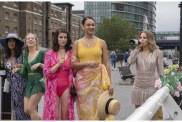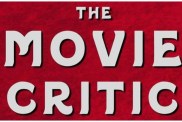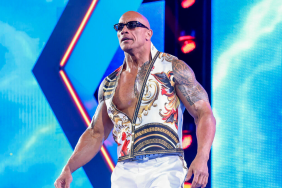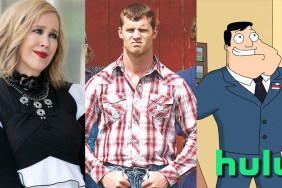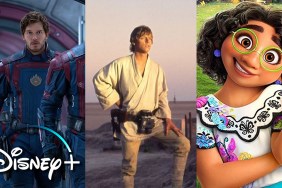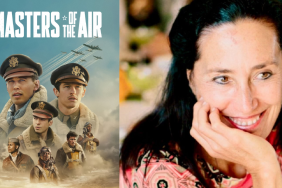From the brilliant visionary mind of Japanese Academy Award winner Hayao Miyazaki comes a story about a magical goldfish named Ponyo (voiced by Nora Cyrus) who is determined to become human after swimming away from her underwater home and meets a 5-year-old boy named Sosuke (voiced by Frankie Jonas) who she wants to live with. Her father, the wizard Fujimoto (voiced by Liam Neeson) is desperate to make her come back because she has upset the balance of nature by leaving. When she uses her powers to become a little girl, a gigantic storm is triggered and only her mom, a beautiful sea goddess (voiced by Cate Blanchett) can restore what has happened and make her daughter’s dreams come true.
The vocal cast of Ponyo also includes Matt Damon, Tina Fey and Betty White.
ComingSoon.net sat down and chatted with Hayao Miyazaki, the legendary, world-renowned animator who directed the film, as well as DisneyPixar’s John Lasseter, who served as executive producer. (We should note that Miyazaki does not speak English and the interview was conducted through his translator who accompanied him to the press day.)
Question: What drew you to the story of Ponyo?
Hayao Miyazaki: When I was casting my next within my subconscious, what caught on my net was a little red goldfish and that was Ponyo. If I give a really detailed explanation it gets way too long, but when I think about it now in hindsight, that’s what really how the story started for me.
Q: Can you talk about how “The Little Mermaid” influenced the movie?
Miyazaki: The first book I ever read which was all words–not an illustrated–was [Hans Christian] Andersen’s “Little Mermaid” and I remember being dissatisfied with the ending. So I wanted to make sure in this story the fish girl does not die, but lives strong.
Q: Do most of your films begin with an image that you get like with “Ponyo” or is there a theme you want to stick to?
Miyazaki: They all start with five minutes of images. It’s as if pieces of a jigsaw puzzle are all mixed together and then I search something and find one piece that seems to be a good piece. That one piece in this case was “Ponyo.” Other times it’s other fragments of images. I find other pieces that I like, but they don’t fit with the main image that I want to try to create at that point so I throw them back. It takes me awhile to get up the nerve to throw it away because I really don’t want to throw it away. I want to make it work somehow. It takes me quite awhile.
Q: Who had the say in casting?
John Lasseter: For casting, it was myself along with Kathleen Kennedy and Frank Marshall and sort of our group at Pixar that we put together to do the English language. They were brilliant to work with. We checked all of our suggestions by Miyazaki, but they really left it up to us.
Q: How challenging was it to translate the film into English for you?
Lasseter: We took the Japanese version and translated it directly into English. It was very important for me to understand exactly what he was saying in this film. Then we took that version and worked with Melissa Mathison to adjust it to make it sound very natural. The important thing was for American audiences to come in and get swept away in the story and not think about it being a dubbed Japanese film so they can relate. Then with that script working with the actors the challenge was to not only get the emotional acting, but also to see how many words are going to fit with the right mouth openings, but that actually worked out quite well. As we’d write the dialogue we’d make sure it’s about the right length of what’s being said.
Q: This is an interesting pairing because Miyazaki your films have generally been very beautifully drawn hand animation films and Pixar is largely known for their CG animation films. Do you ever see yourself working in that medium and finding a story is best presented in CG or do you only prefer hand drawing?
Miyazaki: I am no longer thinking of using computer graphics at all. I leave that up to John Lasseter. I think he can do it much better.
Q: You said earlier you would never make a 3-D movie. Why is that?
Miyazaki: I don’t know how to make it so I don’t want to make a 3-D movie.

Q: In this movie you take a step backwards because in previously films you had the aid of computers, but this one is completely hand drawn. Why?
Miyazaki: I realized that the staff had computers coming into their heads. The hand drawn drawings became more awkward because they tried to match the drawings of the computer so I decided to get rid of the computer graphics department in the studio and really go for hand drawn only.
Q: Your films are known for their wildly imaginative imagery. Have you ever had a thought or an image you couldn’t draw or was challenging for you to visualize?
Miyazaki: Well if I come across one of those then I just don’t draw it.
Q: You said earlier in the press conference “Beauty and the Beast” was going to be made into 3-D. Do you have a release date for the film yet?
Lasseter: Valentine’s Day 2010.
Q: Why have “Beauty and the Beast” in 3-D?
Lasseter: It’s one of the recent Disney classics – the kind of “Little Mermaid” era to “Lion King.” It’s so well loved by audiences and it’s a great film – a great love story, so there was a decision to see what we could do with that. It’s really interesting technology because we had to choose a movie that was digitally interpainted so that all of the elements were stored separately so we could access those. They created this very interesting technology. Instead of it being just a bunch of flat plains they actually add some roundness to cell levels. I was somewhat skeptical because I remember those old View-Master images of Donald Duck and they’re also this weird cardboard cutout base. I thought we’ll that’s going to be like it, but actually it was very compelling. For me, one of the biggest things is that it gets the movie back into movie theatres so people can see it on the big screen again. Think about when it came out in 1994 how many kids have been born since then and who have never seen it on the big screen? I think these films are made to be seen on the big screen – the same with “Toy Story” and “Toy Story 2.” I’m excited to get those out to the theatre again.
Q: Do you think there will be a “Toy Story 4”?
Lasseter: I can’t really say.
Q: A lot of people say there are many themes in your films. Do you think there are one or two films that connect all of your movies together?
Miyazaki: I’ve been told by a friend of mine that all of the movies I make are essentially the same so there probably is a theme with all of them.
Q: Can you talk about why you’re so passionate about 3-D?
Lasseter: I’ve always loved 3-D. I did a lot of personal photography in 3-D. I have a number of old 3-D cameras. I experimented with any photography format I could get my hands on in the ’80s. In fact I took my wedding photos in 3-D. In 1989, one of the things I was really personally attracted to [was] computer graphics and computer animation back in the early days. I was the first traditionally trained animator to work with computer animation. It was within the computer you’re dealing with a truly three dimensional world. First it was the camera moves because you know the steady cam had come out. It changed filmmaking. You could do so much with a camera. This is like doing a steady cam shot in animation. You can move in and around an object. Then once I started getting into 3-D photography I started looking at wait a minute – we can do 3-D imagery with computer animation. It’s truly round. It’s not like cardboard cutouts. We started experimenting and in 1989 I think we did one of the first stereo 3-D computer animated films with “Knick Knack” and the problem was there was absolutely no theatre to see it in. For 16 years I never saw it in 3-D. When we started making “Toy Story,” our first feature film we really were transforming the way we thought about filmmaking with live action film grammar you know understand it because we were dealing with a two-three dimensional world. In a weird way we kept saying we were making 3-D films all along. We were just seeing them with one eye closed. For me, what I love about it, it shows what the world is like we’re truly creating. I think its fun. I think it adds a certain level of entertainment to a film. For me also, it’s all about storytelling and we understand what you can and can’t do with 3-D. We tend to do things more with the depth. We don’t really resort to the gimmickie stuff coming at you. That’s kind of gotten old, but also it takes you out of the movie.
Ponyo hits theaters on Friday, August 14.

